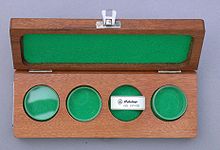- Optical flat
-
Optical flats are optical-grade pieces of glass lapped and polished to be extremely flat on one or both sides, usually within a few millionths of an inch (about 25 nanometres). They are used with a monochromatic light to determine the flatness of other optical surfaces by interference.[1] When an optical flat is placed on another surface and illuminated, the light waves reflect off both the bottom surface of the flat and the surface it is resting on. The reflected waves interfere, creating a pattern of interference fringes (Newton's rings), visible as light and dark bands. The spacing between the fringes is smaller where the gap is changing more rapidly, indicating a departure from flatness in one of the two surfaces, in a similar way to the contour lines on a map. A flat surface is indicated by a pattern of straight, parallel fringes with equal spacing, while other patterns indicate uneven surfaces. Two adjacent fringes indicate a difference in elevation of one-half wavelength of the light used, so by counting the fringes differences in elevation of the surface can be measured to millionths of an inch.
Usually only one of the two surfaces is made optically flat to the specified tolerance, and this surface is indicated by an arrow on the edge of the glass.
Optical flats are sometimes given an optical coating and used as precision mirrors for special purposes, such as in a Fabry–Pérot interferometer or laser cavity. Optical flats have uses in spectrophotometry as well.
See also
References
- ^ English, R. E. (1953). "Optical Flats". In Ingalls, Albert G.. Amateur Telescope Making, Book Three. Scientific American. pp. 156–162.
Categories:- Optics stubs
- Optical devices
Wikimedia Foundation. 2010.



